2015六年级英语总复习
图片预览
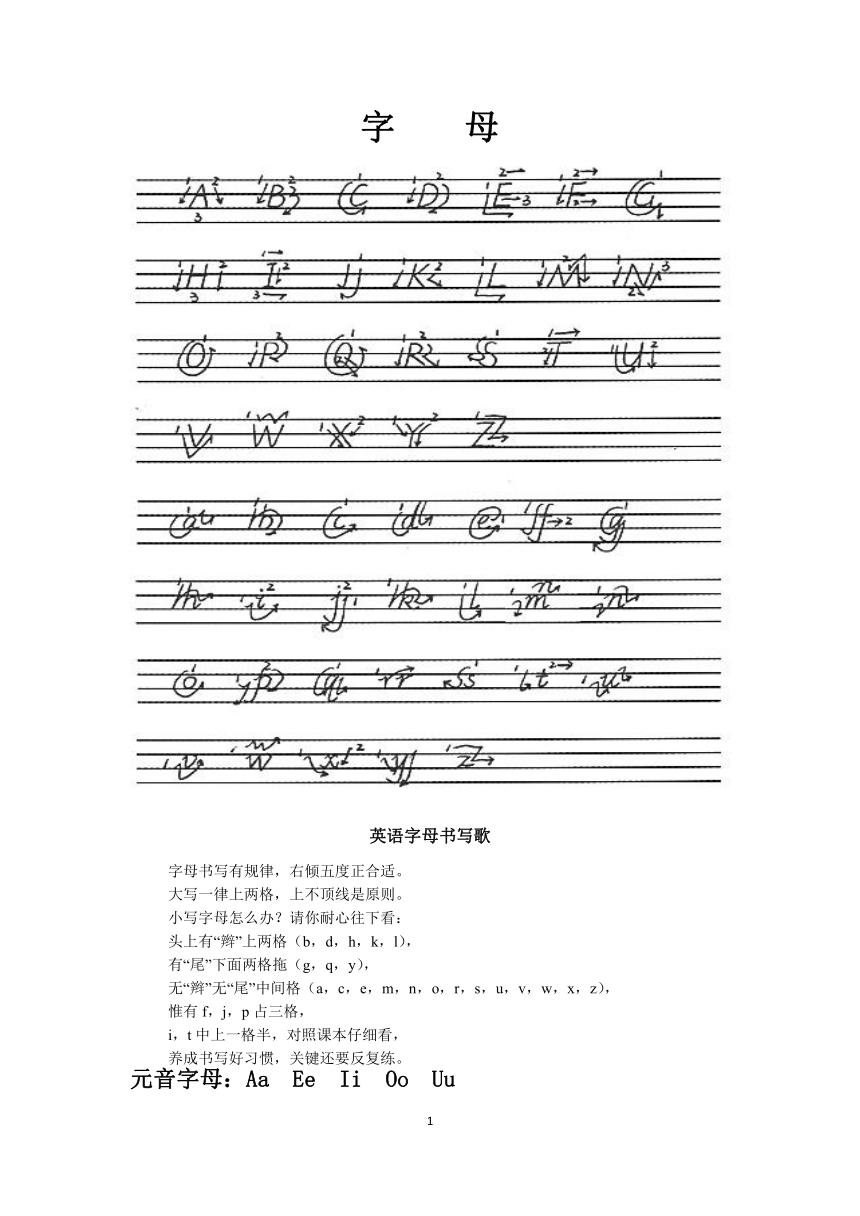
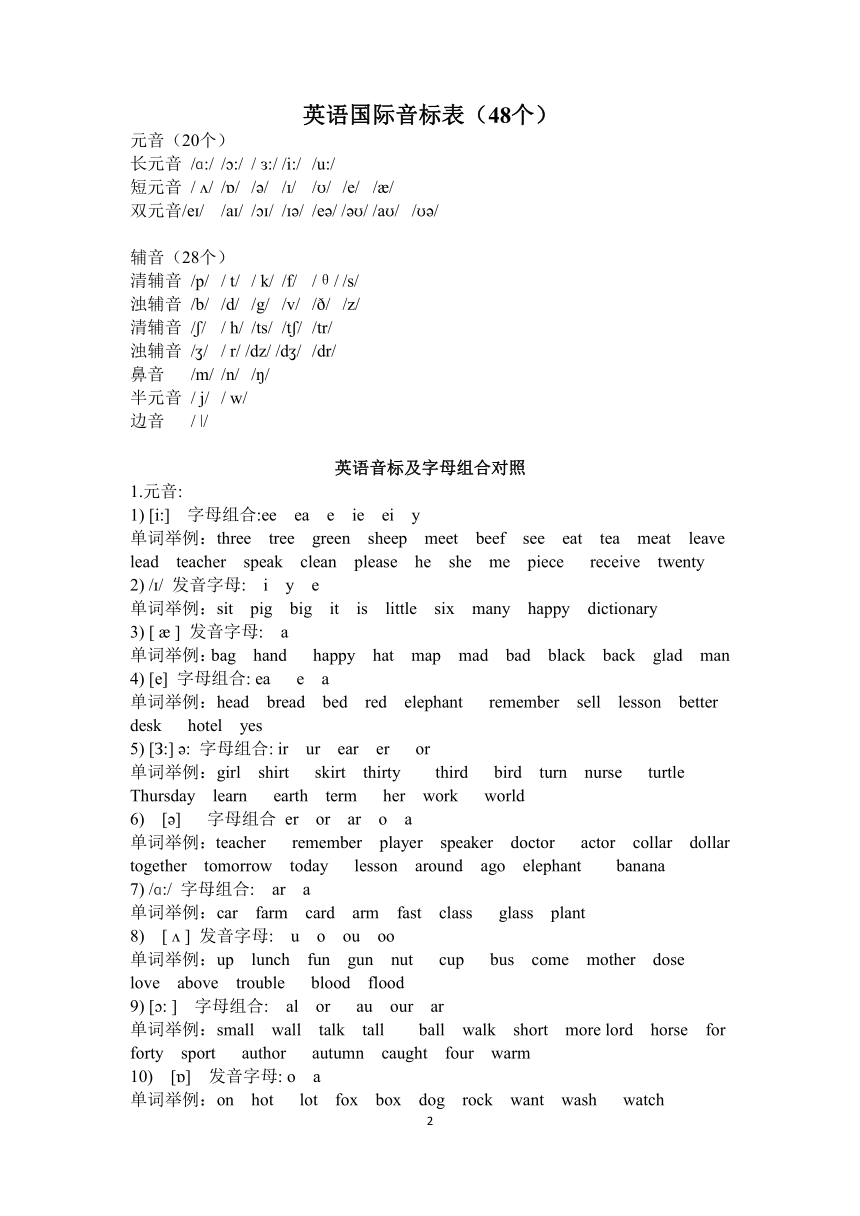
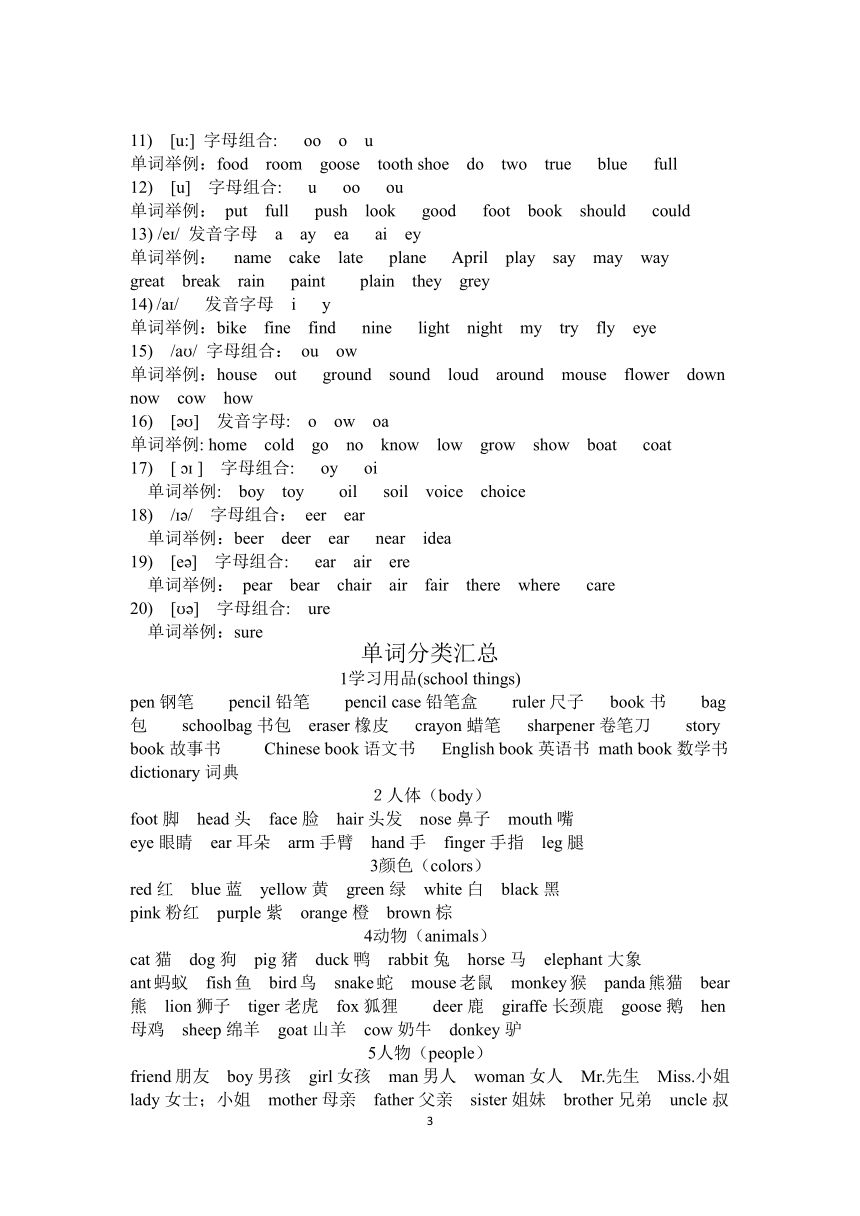
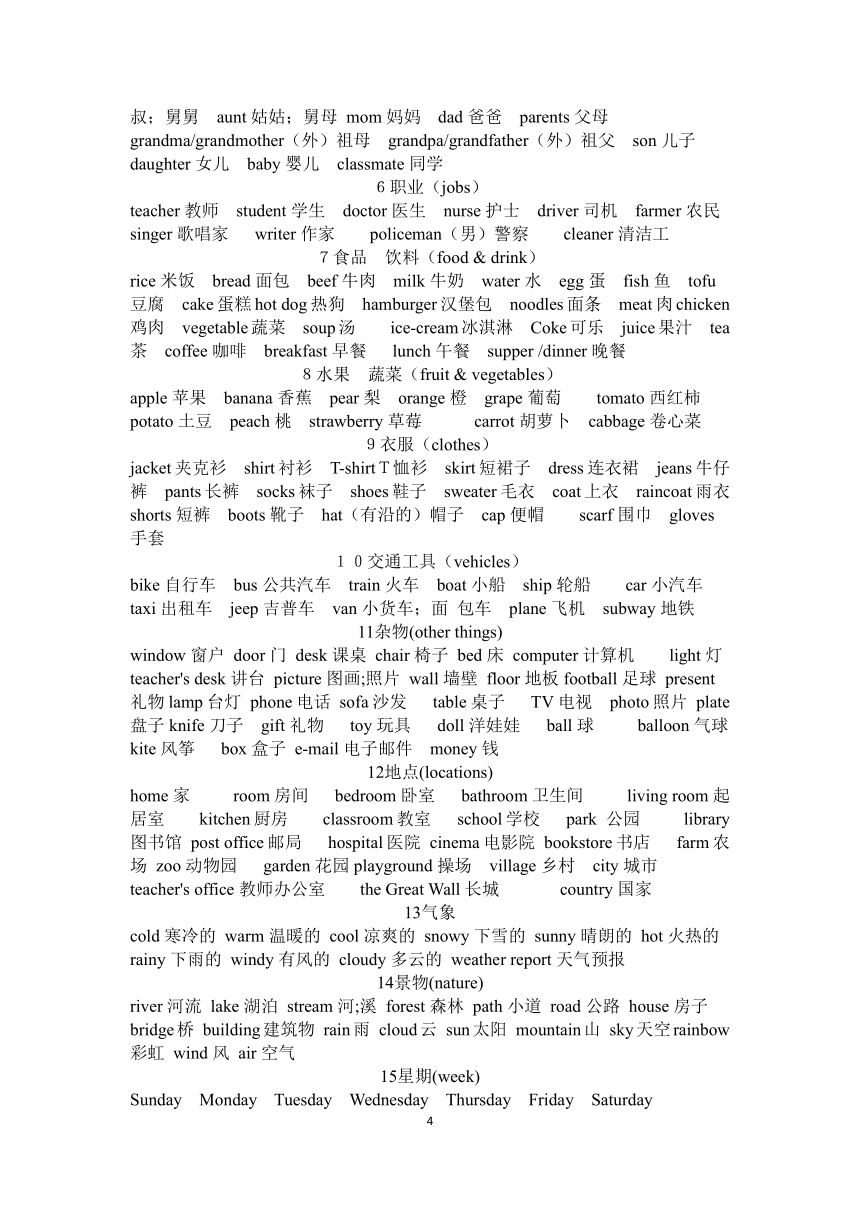
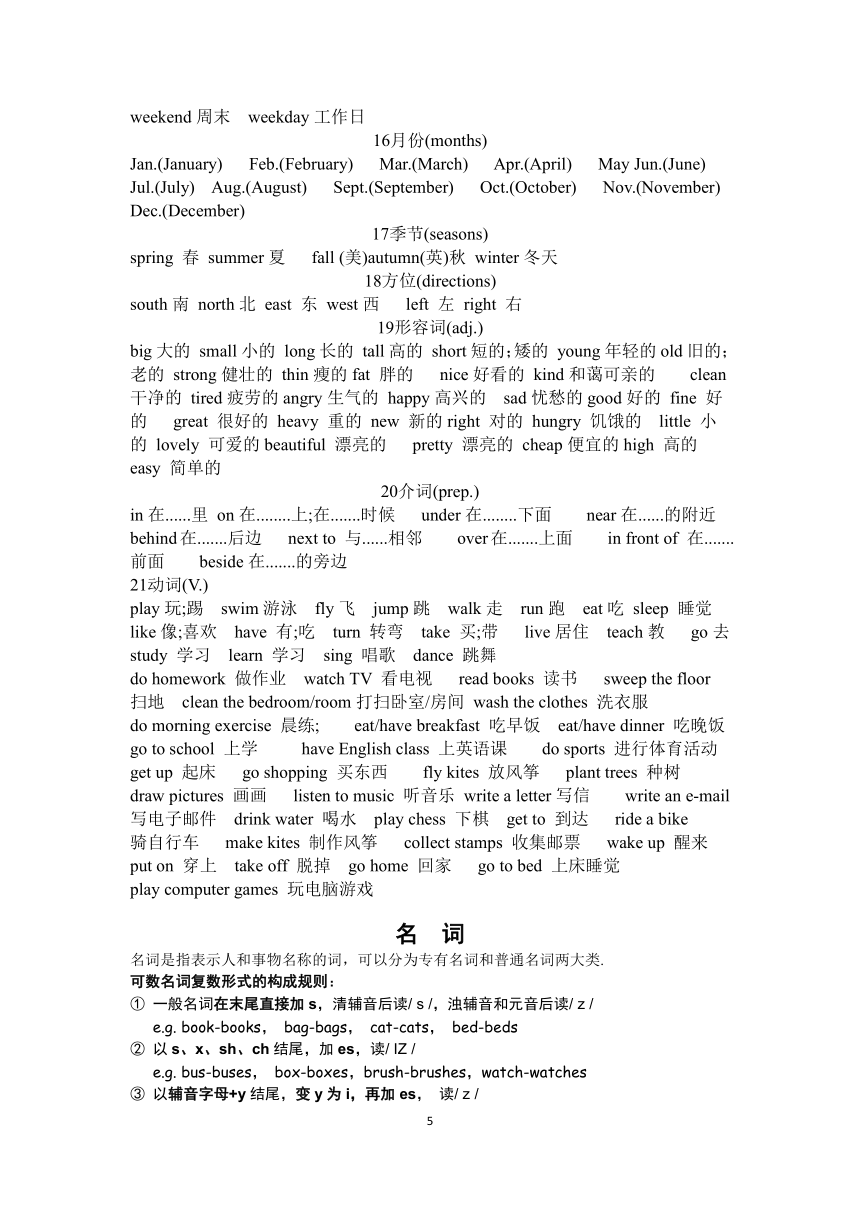
文档简介
字 母
/
英语字母书写歌
字母书写有规律,右倾五度正合适。
大写一律上两格,上不顶线是原则。
小写字母怎么办?请你耐心往下看:
头上有“辫”上两格(b,d,h,k,l),
有“尾”下面两格拖(g,q,y),
无“辫”无“尾”中间格(a,c,e,m,n,o,r,s,u,v,w,x,z),
惟有f,j,p占三格,
i,t中上一格半,对照课本仔细看,
养成书写好习惯,关键还要反复练。
元音字母:Aa Ee Ii Oo Uu
英语国际音标表(48个)
元音(20个)
长元音 /ɑ:/ /?:/ / ?:/ /i:/ /u:/
短元音 / ?/ /?/ /?/ /?/ /?/ /e/ /?/
双元音/e?/ /a?/ /??/ /??/ /e?/ /??/ /a?/ /??/
辅音(28个)
清辅音 /p/ / t/ / k/ /f/ /θ/ /s/
浊辅音 /b/ /d/ /g/ /v/ /e/ /z/
清辅音 /?/ / h/ /ts/ /t?/ /tr/
浊辅音 /?/ / r/ /dz/ /d?/ /dr/
鼻音 /m/ /n/ /?/
半元音 / j/ / w/
边音 / ?/
英语音标及字母组合对照
1.元音:
1) [i:] 字母组合:ee ea e ie ei y
单词举例:three tree green sheep meet beef see eat tea meat leave lead teacher speak clean please he she me piece receive twenty
2) /?/ 发音字母: i y e
单词举例:sit pig big it is little six many happy dictionary
3) [ ? ] 发音字母: a
单词举例:bag hand happy hat map mad bad black back glad man
4) [e] 字母组合: ea e a
单词举例:head bread bed red elephant remember sell lesson better desk hotel yes
5) [З:] ?: 字母组合: ir ur ear er or
单词举例:girl shirt skirt thirty third bird turn nurse turtle Thursday learn earth term her work world
6) [?] 字母组合 er or ar o a
单词举例:teacher remember player speaker doctor actor collar dollar together tomorrow today lesson around ago elephant banana
7) /ɑ:/ 字母组合: ar a
单词举例:car farm card arm fast class glass plant
8) [ ? ] 发音字母: u o ou oo
单词举例:up lunch fun gun nut cup bus come mother dose love above trouble blood flood
9) [?: ] 字母组合: al or au our ar
单词举例:small wall talk tall ball walk short more lord horse for forty sport author autumn caught four warm
10) [?] 发音字母: o a
单词举例:on hot lot fox box dog rock want wash watch
11) [u:] 字母组合: oo o u
单词举例:food room goose tooth shoe do two true blue full
12) [u] 字母组合: u oo ou
单词举例: put full push look good foot book should could
13) /e?/ 发音字母 a ay ea ai ey
单词举例: name cake late plane April play say may way
great break rain paint plain they grey
14) /a?/ 发音字母 i y
单词举例:bike fine find nine light night my try fly eye
15) /a?/ 字母组合: ou ow
单词举例:house out ground sound loud around mouse flower down now cow how
16) [??] 发音字母: o ow oa
单词举例: home cold go no know low grow show boat coat
17) [ ?? ] 字母组合: oy oi
单词举例: boy toy oil soil voice choice
18) /??/ 字母组合: eer ear
单词举例:beer deer ear near idea
19) [e?] 字母组合: ear air ere
单词举例: pear bear chair air fair there where care
20) [??] 字母组合: ure
单词举例:sure
单词分类汇总
1学习用品(school things)
pen钢笔 pencil铅笔 pencil case铅笔盒 ruler尺子 book书 bag包 schoolbag书包 eraser橡皮 crayon蜡笔 sharpener卷笔刀 story book故事书 Chinese book语文书 English book英语书 math book数学书 dictionary词典
2人体(body)
foot脚 head头 face脸 hair头发 nose鼻子 mouth嘴
eye眼睛 ear耳朵 arm手臂 hand手 finger手指 leg腿
3颜色(colors)
red红 blue蓝 yellow黄 green绿 white白 black黑
pink粉红 purple紫 orange橙 brown棕
4动物(animals)
cat猫 dog狗 pig猪 duck鸭 rabbit兔 horse马 elephant大象
ant蚂蚁 fish鱼 bird鸟 snake蛇 mouse老鼠 monkey猴 panda熊猫 bear熊 lion狮子 tiger老虎 fox狐狸 deer鹿 giraffe长颈鹿 goose鹅 hen母鸡 sheep绵羊 goat山羊 cow奶牛 donkey驴
5人物(people)
friend朋友 boy男孩 girl女孩 man男人 woman女人 Mr.先生 Miss.小姐 lady女士;小姐 mother母亲 father父亲 sister姐妹 brother兄弟 uncle叔叔;舅舅 aunt姑姑;舅母 mom妈妈 dad爸爸 parents父母grandma/grandmother(外)祖母 grandpa/grandfather(外)祖父 son儿子 daughter女儿 baby婴儿 classmate同学
6职业(jobs)
teacher教师 student学生 doctor医生 nurse护士 driver司机 farmer农民 singer歌唱家 writer作家 policeman(男)警察 cleaner清洁工
7食品 饮料(food & drink)
rice米饭 bread面包 beef牛肉 milk牛奶 water水 egg蛋 fish鱼 tofu豆腐 cake蛋糕hot dog热狗 hamburger汉堡包 noodles面条 meat肉chicken鸡肉 vegetable蔬菜 soup汤 ice-cream冰淇淋 Coke可乐 juice果汁 tea茶 coffee咖啡 breakfast早餐 lunch午餐 supper /dinner晚餐
8水果 蔬菜(fruit & vegetables)
apple苹果 banana香蕉 pear梨 orange橙 grape葡萄 tomato西红柿 potato土豆 peach桃 strawberry草莓 carrot胡萝卜 cabbage卷心菜
9衣服(clothes)
jacket夹克衫 shirt衬衫 T-shirtT恤衫 skirt短裙子 dress连衣裙 jeans牛仔裤 pants长裤 socks袜子 shoes鞋子 sweater毛衣 coat上衣 raincoat雨衣 shorts短裤 boots靴子 hat(有沿的)帽子 cap便帽 scarf围巾 gloves手套
10交通工具(vehicles)
bike自行车 bus公共汽车 train火车 boat小船 ship轮船 car小汽车 taxi出租车 jeep吉普车 van小货车;面 包车 plane飞机 subway地铁
11杂物(other things)
window窗户 door门 desk课桌 chair椅子 bed床 computer计算机 light灯 teacher's desk讲台 picture图画;照片 wall墙壁 floor地板football足球 present礼物lamp台灯 phone电话 sofa沙发 table桌子 TV电视 photo照片 plate盘子knife刀子 gift礼物 toy玩具 doll洋娃娃 ball球 balloon气球 kite风筝 box盒子 e-mail电子邮件 money钱
12地点(locations)
home家 room房间 bedroom卧室 bathroom卫生间 living room起居室 kitchen厨房 classroom教室 school学校 park 公园 library图书馆 post office邮局 hospital医院 cinema电影院 bookstore书店 farm农场 zoo动物园 garden花园playground操场 village乡村 city城市
teacher's office教师办公室 the Great Wall长城 country国家
13气象
cold寒冷的 warm温暖的 cool凉爽的 snowy下雪的 sunny晴朗的 hot火热的 rainy下雨的 windy有风的 cloudy多云的 weather report天气预报
14景物(nature)
river河流 lake湖泊 stream河;溪 forest森林 path小道 road公路 house房子bridge桥 building建筑物 rain雨 cloud云 sun太阳 mountain山 sky天空rainbow彩虹 wind风 air空气
15星期(week)
Sunday Monday Tuesday Wednesday Thursday Friday Saturday weekend周末 weekday工作日
16月份(months)
Jan.(January) Feb.(February) Mar.(March) Apr.(April) May Jun.(June) Jul.(July) Aug.(August) Sept.(September) Oct.(October) Nov.(November) Dec.(December)
17季节(seasons)
spring 春 summer夏 fall (美)autumn(英)秋 winter冬天
18方位(directions)
south南 north北 east 东 west西 left 左 right 右
19形容词(adj.)
big大的 small小的 long长的 tall高的 short短的;矮的 young年轻的old旧的;老的 strong健壮的 thin瘦的fat 胖的 nice好看的 kind和蔼可亲的 clean干净的 tired疲劳的angry生气的 happy高兴的 sad忧愁的good好的 fine 好的 great 很好的 heavy 重的 new 新的right 对的 hungry 饥饿的 little 小的 lovely 可爱的beautiful 漂亮的 pretty 漂亮的 cheap便宜的high 高的 easy 简单的
20介词(prep.)
in在......里 on在........上;在.......时候 under在........下面 near在......的附近 behind在.......后边 next to 与......相邻 over在.......上面 in front of 在.......前面 beside在.......的旁边
21动词(V.)
play玩;踢 swim游泳 fly飞 jump跳 walk走 run跑 eat吃 sleep 睡觉 like像;喜欢 have 有;吃 turn 转弯 take 买;带 live居住 teach教 go去 study 学习 learn 学习 sing 唱歌 dance 跳舞
do homework 做作业 watch TV 看电视 read books 读书 sweep the floor扫地 clean the bedroom/room打扫卧室/房间 wash the clothes 洗衣服
do morning exercise 晨练; eat/have breakfast 吃早饭 eat/have dinner 吃晚饭 go to school 上学 have English class 上英语课 do sports 进行体育活动 get up 起床 go shopping 买东西 fly kites 放风筝 plant trees 种树
draw pictures 画画 listen to music 听音乐 write a letter写信 write an e-mail 写电子邮件 drink water 喝水 play chess 下棋 get to 到达 ride a bike 骑自行车 make kites 制作风筝 collect stamps 收集邮票 wake up 醒来 put on 穿上 take off 脱掉 go home 回家 go to bed 上床睡觉
play computer games 玩电脑游戏
名 词
名词是指表示人和事物名称的词,可以分为专有名词和普通名词两大类.
可数名词复数形式的构成规则:
① 一般名词在末尾直接加s,清辅音后读/ s /,浊辅音和元音后读/ z /
e.g. book-books, bag-bags, cat-cats, bed-beds
② 以s、x、sh、ch结尾,加es,读/ IZ /
e.g. bus-buses, box-boxes,brush-brushes,watch-watches
③ 以辅音字母+y结尾,变y为i,再加es, 读/ z /
e.g. baby-babies, library-libraries,factory-factories
④ 以f或fe结尾,变f或fe为v,再加es,读/ vz /
e.g. thief-thieves,knife-knives
⑤ 以o结尾,表示无生命的物体时加s, 表示有生命的物体时,加es,都读/ z /
e.g. photo-photos, piano-pianos, radio-radios, zoo-zoos
potato-potatoes,tomato-tomatoes,mango-mangoes,hero-heroes
⑥ 不规则变化
e.g. man-men policeman-policemen woman-women
mouse-mice child-children
tooth-teeth goose-geese foot-feet
fish-fish sheep-sheep deer-deer
冠词
冠词一般用在名词的前面,对名词起限定作用,不能离开名词单独存在。
1、不定冠词a,an用在单数可数名词前面,泛指一类人或物中的任何一个。
① a用于辅音音素开头的名词之前。e.g. a bed,a computer,a “U”
② an用于元音音素开头的名词之前。 e.g. an egg,an umbrella,an hour
2、定冠词the用在单数或复数可数名词前,也可用在不可数名词前。
① 表示特指的人或物前。
e.g. The man with a flower in his hand is Jack.
② 指说话人双方都知道的人或物前。
e.g. Lily, close the door, please.
③ 在上文提到过,第二次又提到的人或物前。
e.g. There is a man under the tree. The man is called James.
表示世界上独一无二的事物前。
e.g. The sun is bigger than the moon.
用在序数词前面。
e.g. It is the first day of the new term.
用在乐器名称前。
e.g. He often plays the violin at weekends.
用在形容词最高级前。
e.g. Spring is the best season in a year.
用在由普通名词构成的专有名词前。
e.g. I went to the Great Wall last week.
⑨ 用在国家名称的缩写前。
e.g. He is from the UK.
代 词
1、人称代词:表示“我、你、他、她、它、我们、你们、他们”的词。
我
你
他
她
它
我们
你们
他们
主格
I
you
he
she
it
we
you
they
宾格
me
you
him
her
it
us
you
them
①主格一般用在句子开头做主语,通常用在动词前。
e.g. I am a student. They are cleaning the classroom.
②宾格可以用来表示动作行为的对象,一般用在动词和介词后面。
e.g. Ask her, please. Listen to me carefully.
2、物主代词:表示所有关系的代词叫物主代词。
我的
你的
他的
她的
它的
我们的
你们的
他们的
形容词性
my
your
his
her
its
our
your
their
名 词 性
mine
yours
his
hers
its
ours
yours
theirs
①形容词性物主代词后面一般要带上名词。如:my watch, his cousin, our school
②名词性物主代词本身就可以看作是名词,故其后不能再加名词,可单独使用。
3、不定代词:没有明确指定代替某个(些)人或物的词叫不定代词。
(1)some和any
都表示“一些”,既可以修饰可数名词,也可以修饰不可数名词。
① some多用在肯定句中,any多用在否定句和疑问句中。
e.g. There are some flowers in the garden. (肯定句)
There isn’t any milk in the fridge. (否定句)
Do you have any hobbies? (疑问句)
② 在表示邀请和希望对方给予肯定回答的疑问句中也要用some。
e.g. —Would you like some coffee? —Yes, please. (邀请)
—Mum, can I have some peaches? —Sure.(希望对方给予肯定回答)
4.疑问代词:用来表达疑问或构成疑问句的代词,一般放在疑问句的句首。
what
问什么
—What’s your name? —My name is Tom.
What colour
问颜色
—What colour is your coat? —It’s red.
what day
问星期
—What day is it today? —It’s Monday.
what date
问日期
—What date is it today? —It’s the first of June.
what shape
问形状
—What shape is the moon? —It’s round.
what…job
问工作
—What’s your father’s job? —He’s a bus driver.
what time
问时间
—What time is it? —It’s ten o’clock.
when
问时候
—When is your birthday? —It’s on the first of May.
which
问哪个
—Which is your watch, this one or that one? —That one.
where
问地点
—Where is my pen? —It’s on the floor.
who
问谁
—Who is the boy with big eyes? —He’s Liu Tao.
whose
问谁的
—Whose bag is this? —It’s Helen’s.
why
问原因
—Why are you absent today? —I’m ill.
how
问方式
—How do you go to school? —By bus.
how many
问数量
—How many books are there? —There are five.
how much
问价钱
—How much is it? —Twenty yuan.
how old
问年龄
—How old are you? —I’m twelve.
how far
问距离
—How far is it from here? —It’s about one kilometer.
how about
问情况
—I’m thirsty. How about you? —Me, too.
形容词
形容词用来修饰名词或代词,表示人或事物的性质、状态和特征。它的位置通常放在被修饰的名词前,也可以放在be动词和look、feel、taste、sound、get之后。
在英语中,形容词有三个等级,即原级、比较级和最高级。
1、表示两者“等同”时用原级,结构为:as+原级+as,表示“xx和xx一样……”
e.g. Are you as tall as your twin sister?
其否定形式结构为:not+as+原级+as,表示“xx和xxx不一样……”
e.g. I’m not as tall as you.
2、表示两者“比较”时用比较级,结构为:比较级+than,表示“xx比xxx更……”
e.g. He’s one year younger than me.
形容词比较级的构成规则:
一般在词尾加er
e.g. taller,longer,stronger,younger
以字母e结尾,只加r
e.g. late-later,nice-nicer
以辅音字母+y结尾,变y为i,再加er
e.g. heavy-heavier
双写末尾的辅音字母,再加er
e.g. fat-fatter,thin-thinner,big-bigger
双音节和多音节词的比较级,在原级前加more
e.g. more beautiful,more careful
不规则变化
e.g. good-better,many / much-more,far-farther,bad / ill-worse
3、三个或三个以上的人或物进行比较,用形容词最高级。
结构为:the + 形容词最高级 +in/of等表示范围的短语,表示“最……”。
e.g. Autumn is the best season in New York.
She is the tallest girl of our three.
动词
动词是表示动作或行为的词。按其词义和在句子中的作用可以分为系动词、助动词、情态动词和行为动词。
1、be动词(am,is,are)
① be动词做谓语时,要与主语在人称和数上保持一致。
用法口诀: 我用am,你用are,is 用在他、她、它;单数用is,复数全用are。
如:I am a teacher. You are a student. She is a nurse. We are Chinese.
② be动词的否定形式:am not(无缩写形式),is not=isn’t,are not=aren’t
2、助动词(do,does,did)
① do,does用于一般现在时,does用于第三人称单数,其他人称和数用do。其过去式did用于一般过去时。他们通常用在疑问句和否定句中。助动词后动词要用原形。
如:Do you like this film?
Does she like playing football?
I didn’t go to school yesterday.
② 否定形式:do not = don’t,does not =doesn’t,did not=didn’t
3、情态动词(can,may,must,should,will,would,shall等)
情态动词表示说话人对某一动作或状态的态度,表示“可能”,“可以”,“需要”,“必须”,“应当”等意思。情态动词没有人称和数的变化,后面的动词要用原形。
现在进行时构成(ing形式)
构 成 法
例 词
A.一般加-ing
work -- working
study -- studying
B.以e结尾的词去e后加-ing
live -- living
write -- writing
C.动词为单音节:以单一元音字母+单一辅音字母结尾,辅音字母双写,再加ing;动词为双音节或者多音节:最后一个音节为重读音节,以单一元音字母+单一辅音字母结尾,辅音字母双写,再加 ing
stop -- stopping
run -- running
swim -- swimming
begin -- beginning
一般现在时(三单形式)
构 成 法
例 词
A.一般动词在词尾加-s
help -- helps
make -- makes
B.以s, x , ch,sh,结尾的动词在词尾加-es
fix -- fixes
teach -- teaches
wash -- washes
C.以o结尾的动词在词尾加-es
go -- goes
do -- does
D.以辅音字母加y结尾的动词,先y变为i,再加-es
fly -- flies
study -- studies
carry -- carries
E.不规则变化
have -- has
形容词比较级(er形式)
构 成 法
例 词
A.一般直接加-er
long -- longer
B.如果以-e结尾,直接加-r
nice -- nicer
C.闭音节词如末尾只有一个辅音字母须双写这个字母,再加-er
big -- bigger
D.以辅音字母加-y结尾的词,变y为i,再加-er
heavy -- heavier
完全、缩略形式:
I’m=I am he’s=he is she’s=she is they’re=they are you’re=you are there’s=there is they’re=they are can’t=can not don’t=do not doesn’t=does not isn’t=is not aren’t=are not let’s=let us won’t=will not I’ll=I will wasn’t=was not
总结:通常情况下,'m即am,'s即is(但 let’s=let us), 're即are ,n't即not (但can’t=can not)
句型专项归类
1、 肯定句:是指用肯定的语气来陈述的句子,如:
I’m a student. She is a doctor. He works in a hospital.
There are four fans in our classroom. He will eat lunch at 12:00. I watched TV yesterday evening.
2、否定句:含有否定词或表示否定意义词的句子,如:I’m not a student. She is not (isn’t) a doctor.
He does not (doesn’t) work in a hospital. There are not (aren’t) four fans in our classroom.
He will not (won’t) eat lunch at 12:00. I did not (didn’t) watch TV yesterday evening.
☆注意 小结:否定句主要是在肯定句的基础上加上了否定词 “not”。有动词be的句子则“not”加在be后面,可缩写成“isn’t,aren’t”,但am not 一般都分开写。没有动词be的句子则要先在主要动词的前面加上一个助动词(do,does,did),然后在它后面加上“not”,你也可以把它们缩写在一起如“don’t , doesn’t , didn’t )。这三个助动词要根据人称和时态来选择,其中“does”只用于一般现在时主语是第三人称单数的情况,而“did”只用于一般过去时,不论主语是什么人称和数,都用“did” 。
3、一般疑问句:是指询问事实的句子,此类句子必须用“yes”,或“no”来回答。
如:Are you a student? Yes, I am / No, I’m not.
Is she a doctor? Yes, she is. / No, she isn’t.
Does he work in a hospital? Yes, he does. / No, he doesn’t.
Are there four fans in our classroom? Yes, there are. / No, there aren’t.
Are you going to buy a comic book tonight? Yes, I am. / No, I am not. (Yes, we are. / No, we aren’t.)
Will he eat lunch at 12:00? Yes, I will. / No, I will not(won’t).
Are they swimming? Yes, they are. / No, they aren’t.
Did you watch TV yesterday evening? Yes, I did. / No, I didn’t.
☆注意 小结:一般疑问句是在肯定句的基础上,
①把动词be调到首位,其他照写,末尾标点符号变成问号即可。
②没有动词be的句子则要在句首加上一个助动词(do,does,did)再把紧跟在后面的动词变回原形,末尾标点符号变成问号即可。
这三个助动词也要根据人称和时态来选择,其中“does”只用于一般现在时主语是第三人称单数的情况,而“did”只用于一般过去时,不论主语是什么人称和数,都用“did” 。一般疑问句有个重要的原则就是问和答要一致,即问句里的第一个单词(助动词)和简略答句里的这个词是一致的。
4、特殊疑问句:以特殊疑问词(what , where , who , which , when , whose , why , how等)开头引导的句子。此类句子应该问什么就答什么,不能用“yes 、no”来回答。如:
What is this? It’s a computer.
What does he do? He’s a doctor.
Where are you going? I’m going to Beijing.
Who played football with you yesterday afternoon? Mike.
Which season do you like best? Summer.
When do you usually get up? I usually get up at 6:30.
Whose skirt is this? It’s Amy’s.
Why do you like spring best? Because I can plant trees.
How are you? I’m fine. / I’m happy.
How did you go to Xinjiang? I went to Xinjiang by train.
☆其中how又可以和其他一些形容词连用组成特殊疑问词组用来提问,如: how many(多少(数量)),
how much(多少(钱)), how tall(多高), how long(多长), how big(多大), how heavy(多重)
例句:How many pencils do you have? I have three pencils.
How many girls can you see? I can see four girls.
How many desks are there in your classroom? There are 51.
☆小结:how many 用来提问可数名词的数量,主要有以上三种句式搭配,
How many + 名词复数 + do you have? 你有多少……?
How many + 名词复数 + can you see? 你能看见多少……?
How many + 名词复数 + are there…? 有多少……?
日常问候和答语
1. Hello/ Hi你好。
3. Good morning/ afternoon/evening. 早上/下午/晚上好。
4. How are you(this morning/afternoon/evening)? 你今天早晨/下午/晚上好吗?
5. Fine, thank you/ thanks. 我很好,谢谢。
6. Not bad, thank you. 不错,谢谢。
7. How do you do? 你好。
8. Nice to meet /see you. 很高兴认识/见到你。
二、告别、祝福和答语
1. Goodbye/Bye . 再见
2. See you! (See you later!)再见,回头见。
3. Good night. 晚安。
4. Happy birthday! 生日快乐! Thank you!谢谢!
5. Happy New Year! 新年快乐! Happy New Year!/ The same to you!(大家共同的节日)
6. Happy Children’s Day! Happy Women’s Day!
7.Merry Christmas! 圣诞快乐!
三、询问外貌1. What is he like? He is short and thin. 他很矮很瘦。
四、道歉和答语
1. I’m sorry. 对不起。
2. Sorry, I don’t know. 对不起,我不知道。
3. Excuse me. 对不起,打扰一下。
4. I have a cold. 我感冒了。 I’m sorry to hear that. 我很遗憾听到这个消息。
五、感谢和答语
1. Thank you./ Thanks. 谢谢。 You’re welcome. 不用谢。/ That’s OK. 没关系。
2. It’s very kind of you (to help me ). 帮助我你真是太好了。
六、请求允许和答语
1.May I come in? 我可以进来吗? Come in, please. 请进。
2. Can I have two cakes? 我能吃两个蛋糕吗? No, you can’t. 不,你不能。
3. Can I have one,please? 我能吃一个吗? Yes./All right. Here you are. 好的。给你。
4. Can I go with you? 我能和你一起走吗? Sure. 好的
七、建议和劝告
1. Shall we play football together? All right. 好的。2. Let’s go to school. OK/ Good idea.
3. Don’t open your book. 不要打开书。
八、邀请
3. Would you like some cakes? Yes, I’d like. / No, thanks.
九、购物
1. Can I help you? 我能帮你吗? Yes, a dress for my daughter. 是的,给我女儿买条裙子。
2.What can I do for you? 我能为你做点什么吗? I’d like …我想买。。。
3. What do you want, a dress or a skirt? 你想要买什么?连衣裙还是短裙?
4. How about the blue one? 这条蓝色的如何?
5. How much is it/ are they? 多少钱? Fifty-nine yuan. 五十九元。
6. What color would you like? 你要什么颜色的? Green 绿色。
7.What size do you want? 你要多大号码? Size 8. 八号。
8. What / How about this red one? 这件红色的怎么样?
9. It’s too big/small/expensive/….Do you have some big/small ones? 这件太小,你有大一点的?
10.I’ll take it (them). 我买了。11. Here you are. 给你。 Thank you.谢谢。
十、打电话
1. Hello, this is … / This is … speaking. 你好,我是。。。
2. Can I speak to …, please? 我能找。。。接电话吗?
3. Who’s that? / Who is speaking? 你是谁?
4. Is that…? 你是。。。。吗?
5. Hold on. / Just for a moment, please! 稍等, 别挂断。
6. It’s for you. 你的电话。
7.What’s your telephone number? 你的电话号码是什么?
/
英语字母书写歌
字母书写有规律,右倾五度正合适。
大写一律上两格,上不顶线是原则。
小写字母怎么办?请你耐心往下看:
头上有“辫”上两格(b,d,h,k,l),
有“尾”下面两格拖(g,q,y),
无“辫”无“尾”中间格(a,c,e,m,n,o,r,s,u,v,w,x,z),
惟有f,j,p占三格,
i,t中上一格半,对照课本仔细看,
养成书写好习惯,关键还要反复练。
元音字母:Aa Ee Ii Oo Uu
英语国际音标表(48个)
元音(20个)
长元音 /ɑ:/ /?:/ / ?:/ /i:/ /u:/
短元音 / ?/ /?/ /?/ /?/ /?/ /e/ /?/
双元音/e?/ /a?/ /??/ /??/ /e?/ /??/ /a?/ /??/
辅音(28个)
清辅音 /p/ / t/ / k/ /f/ /θ/ /s/
浊辅音 /b/ /d/ /g/ /v/ /e/ /z/
清辅音 /?/ / h/ /ts/ /t?/ /tr/
浊辅音 /?/ / r/ /dz/ /d?/ /dr/
鼻音 /m/ /n/ /?/
半元音 / j/ / w/
边音 / ?/
英语音标及字母组合对照
1.元音:
1) [i:] 字母组合:ee ea e ie ei y
单词举例:three tree green sheep meet beef see eat tea meat leave lead teacher speak clean please he she me piece receive twenty
2) /?/ 发音字母: i y e
单词举例:sit pig big it is little six many happy dictionary
3) [ ? ] 发音字母: a
单词举例:bag hand happy hat map mad bad black back glad man
4) [e] 字母组合: ea e a
单词举例:head bread bed red elephant remember sell lesson better desk hotel yes
5) [З:] ?: 字母组合: ir ur ear er or
单词举例:girl shirt skirt thirty third bird turn nurse turtle Thursday learn earth term her work world
6) [?] 字母组合 er or ar o a
单词举例:teacher remember player speaker doctor actor collar dollar together tomorrow today lesson around ago elephant banana
7) /ɑ:/ 字母组合: ar a
单词举例:car farm card arm fast class glass plant
8) [ ? ] 发音字母: u o ou oo
单词举例:up lunch fun gun nut cup bus come mother dose love above trouble blood flood
9) [?: ] 字母组合: al or au our ar
单词举例:small wall talk tall ball walk short more lord horse for forty sport author autumn caught four warm
10) [?] 发音字母: o a
单词举例:on hot lot fox box dog rock want wash watch
11) [u:] 字母组合: oo o u
单词举例:food room goose tooth shoe do two true blue full
12) [u] 字母组合: u oo ou
单词举例: put full push look good foot book should could
13) /e?/ 发音字母 a ay ea ai ey
单词举例: name cake late plane April play say may way
great break rain paint plain they grey
14) /a?/ 发音字母 i y
单词举例:bike fine find nine light night my try fly eye
15) /a?/ 字母组合: ou ow
单词举例:house out ground sound loud around mouse flower down now cow how
16) [??] 发音字母: o ow oa
单词举例: home cold go no know low grow show boat coat
17) [ ?? ] 字母组合: oy oi
单词举例: boy toy oil soil voice choice
18) /??/ 字母组合: eer ear
单词举例:beer deer ear near idea
19) [e?] 字母组合: ear air ere
单词举例: pear bear chair air fair there where care
20) [??] 字母组合: ure
单词举例:sure
单词分类汇总
1学习用品(school things)
pen钢笔 pencil铅笔 pencil case铅笔盒 ruler尺子 book书 bag包 schoolbag书包 eraser橡皮 crayon蜡笔 sharpener卷笔刀 story book故事书 Chinese book语文书 English book英语书 math book数学书 dictionary词典
2人体(body)
foot脚 head头 face脸 hair头发 nose鼻子 mouth嘴
eye眼睛 ear耳朵 arm手臂 hand手 finger手指 leg腿
3颜色(colors)
red红 blue蓝 yellow黄 green绿 white白 black黑
pink粉红 purple紫 orange橙 brown棕
4动物(animals)
cat猫 dog狗 pig猪 duck鸭 rabbit兔 horse马 elephant大象
ant蚂蚁 fish鱼 bird鸟 snake蛇 mouse老鼠 monkey猴 panda熊猫 bear熊 lion狮子 tiger老虎 fox狐狸 deer鹿 giraffe长颈鹿 goose鹅 hen母鸡 sheep绵羊 goat山羊 cow奶牛 donkey驴
5人物(people)
friend朋友 boy男孩 girl女孩 man男人 woman女人 Mr.先生 Miss.小姐 lady女士;小姐 mother母亲 father父亲 sister姐妹 brother兄弟 uncle叔叔;舅舅 aunt姑姑;舅母 mom妈妈 dad爸爸 parents父母grandma/grandmother(外)祖母 grandpa/grandfather(外)祖父 son儿子 daughter女儿 baby婴儿 classmate同学
6职业(jobs)
teacher教师 student学生 doctor医生 nurse护士 driver司机 farmer农民 singer歌唱家 writer作家 policeman(男)警察 cleaner清洁工
7食品 饮料(food & drink)
rice米饭 bread面包 beef牛肉 milk牛奶 water水 egg蛋 fish鱼 tofu豆腐 cake蛋糕hot dog热狗 hamburger汉堡包 noodles面条 meat肉chicken鸡肉 vegetable蔬菜 soup汤 ice-cream冰淇淋 Coke可乐 juice果汁 tea茶 coffee咖啡 breakfast早餐 lunch午餐 supper /dinner晚餐
8水果 蔬菜(fruit & vegetables)
apple苹果 banana香蕉 pear梨 orange橙 grape葡萄 tomato西红柿 potato土豆 peach桃 strawberry草莓 carrot胡萝卜 cabbage卷心菜
9衣服(clothes)
jacket夹克衫 shirt衬衫 T-shirtT恤衫 skirt短裙子 dress连衣裙 jeans牛仔裤 pants长裤 socks袜子 shoes鞋子 sweater毛衣 coat上衣 raincoat雨衣 shorts短裤 boots靴子 hat(有沿的)帽子 cap便帽 scarf围巾 gloves手套
10交通工具(vehicles)
bike自行车 bus公共汽车 train火车 boat小船 ship轮船 car小汽车 taxi出租车 jeep吉普车 van小货车;面 包车 plane飞机 subway地铁
11杂物(other things)
window窗户 door门 desk课桌 chair椅子 bed床 computer计算机 light灯 teacher's desk讲台 picture图画;照片 wall墙壁 floor地板football足球 present礼物lamp台灯 phone电话 sofa沙发 table桌子 TV电视 photo照片 plate盘子knife刀子 gift礼物 toy玩具 doll洋娃娃 ball球 balloon气球 kite风筝 box盒子 e-mail电子邮件 money钱
12地点(locations)
home家 room房间 bedroom卧室 bathroom卫生间 living room起居室 kitchen厨房 classroom教室 school学校 park 公园 library图书馆 post office邮局 hospital医院 cinema电影院 bookstore书店 farm农场 zoo动物园 garden花园playground操场 village乡村 city城市
teacher's office教师办公室 the Great Wall长城 country国家
13气象
cold寒冷的 warm温暖的 cool凉爽的 snowy下雪的 sunny晴朗的 hot火热的 rainy下雨的 windy有风的 cloudy多云的 weather report天气预报
14景物(nature)
river河流 lake湖泊 stream河;溪 forest森林 path小道 road公路 house房子bridge桥 building建筑物 rain雨 cloud云 sun太阳 mountain山 sky天空rainbow彩虹 wind风 air空气
15星期(week)
Sunday Monday Tuesday Wednesday Thursday Friday Saturday weekend周末 weekday工作日
16月份(months)
Jan.(January) Feb.(February) Mar.(March) Apr.(April) May Jun.(June) Jul.(July) Aug.(August) Sept.(September) Oct.(October) Nov.(November) Dec.(December)
17季节(seasons)
spring 春 summer夏 fall (美)autumn(英)秋 winter冬天
18方位(directions)
south南 north北 east 东 west西 left 左 right 右
19形容词(adj.)
big大的 small小的 long长的 tall高的 short短的;矮的 young年轻的old旧的;老的 strong健壮的 thin瘦的fat 胖的 nice好看的 kind和蔼可亲的 clean干净的 tired疲劳的angry生气的 happy高兴的 sad忧愁的good好的 fine 好的 great 很好的 heavy 重的 new 新的right 对的 hungry 饥饿的 little 小的 lovely 可爱的beautiful 漂亮的 pretty 漂亮的 cheap便宜的high 高的 easy 简单的
20介词(prep.)
in在......里 on在........上;在.......时候 under在........下面 near在......的附近 behind在.......后边 next to 与......相邻 over在.......上面 in front of 在.......前面 beside在.......的旁边
21动词(V.)
play玩;踢 swim游泳 fly飞 jump跳 walk走 run跑 eat吃 sleep 睡觉 like像;喜欢 have 有;吃 turn 转弯 take 买;带 live居住 teach教 go去 study 学习 learn 学习 sing 唱歌 dance 跳舞
do homework 做作业 watch TV 看电视 read books 读书 sweep the floor扫地 clean the bedroom/room打扫卧室/房间 wash the clothes 洗衣服
do morning exercise 晨练; eat/have breakfast 吃早饭 eat/have dinner 吃晚饭 go to school 上学 have English class 上英语课 do sports 进行体育活动 get up 起床 go shopping 买东西 fly kites 放风筝 plant trees 种树
draw pictures 画画 listen to music 听音乐 write a letter写信 write an e-mail 写电子邮件 drink water 喝水 play chess 下棋 get to 到达 ride a bike 骑自行车 make kites 制作风筝 collect stamps 收集邮票 wake up 醒来 put on 穿上 take off 脱掉 go home 回家 go to bed 上床睡觉
play computer games 玩电脑游戏
名 词
名词是指表示人和事物名称的词,可以分为专有名词和普通名词两大类.
可数名词复数形式的构成规则:
① 一般名词在末尾直接加s,清辅音后读/ s /,浊辅音和元音后读/ z /
e.g. book-books, bag-bags, cat-cats, bed-beds
② 以s、x、sh、ch结尾,加es,读/ IZ /
e.g. bus-buses, box-boxes,brush-brushes,watch-watches
③ 以辅音字母+y结尾,变y为i,再加es, 读/ z /
e.g. baby-babies, library-libraries,factory-factories
④ 以f或fe结尾,变f或fe为v,再加es,读/ vz /
e.g. thief-thieves,knife-knives
⑤ 以o结尾,表示无生命的物体时加s, 表示有生命的物体时,加es,都读/ z /
e.g. photo-photos, piano-pianos, radio-radios, zoo-zoos
potato-potatoes,tomato-tomatoes,mango-mangoes,hero-heroes
⑥ 不规则变化
e.g. man-men policeman-policemen woman-women
mouse-mice child-children
tooth-teeth goose-geese foot-feet
fish-fish sheep-sheep deer-deer
冠词
冠词一般用在名词的前面,对名词起限定作用,不能离开名词单独存在。
1、不定冠词a,an用在单数可数名词前面,泛指一类人或物中的任何一个。
① a用于辅音音素开头的名词之前。e.g. a bed,a computer,a “U”
② an用于元音音素开头的名词之前。 e.g. an egg,an umbrella,an hour
2、定冠词the用在单数或复数可数名词前,也可用在不可数名词前。
① 表示特指的人或物前。
e.g. The man with a flower in his hand is Jack.
② 指说话人双方都知道的人或物前。
e.g. Lily, close the door, please.
③ 在上文提到过,第二次又提到的人或物前。
e.g. There is a man under the tree. The man is called James.
表示世界上独一无二的事物前。
e.g. The sun is bigger than the moon.
用在序数词前面。
e.g. It is the first day of the new term.
用在乐器名称前。
e.g. He often plays the violin at weekends.
用在形容词最高级前。
e.g. Spring is the best season in a year.
用在由普通名词构成的专有名词前。
e.g. I went to the Great Wall last week.
⑨ 用在国家名称的缩写前。
e.g. He is from the UK.
代 词
1、人称代词:表示“我、你、他、她、它、我们、你们、他们”的词。
我
你
他
她
它
我们
你们
他们
主格
I
you
he
she
it
we
you
they
宾格
me
you
him
her
it
us
you
them
①主格一般用在句子开头做主语,通常用在动词前。
e.g. I am a student. They are cleaning the classroom.
②宾格可以用来表示动作行为的对象,一般用在动词和介词后面。
e.g. Ask her, please. Listen to me carefully.
2、物主代词:表示所有关系的代词叫物主代词。
我的
你的
他的
她的
它的
我们的
你们的
他们的
形容词性
my
your
his
her
its
our
your
their
名 词 性
mine
yours
his
hers
its
ours
yours
theirs
①形容词性物主代词后面一般要带上名词。如:my watch, his cousin, our school
②名词性物主代词本身就可以看作是名词,故其后不能再加名词,可单独使用。
3、不定代词:没有明确指定代替某个(些)人或物的词叫不定代词。
(1)some和any
都表示“一些”,既可以修饰可数名词,也可以修饰不可数名词。
① some多用在肯定句中,any多用在否定句和疑问句中。
e.g. There are some flowers in the garden. (肯定句)
There isn’t any milk in the fridge. (否定句)
Do you have any hobbies? (疑问句)
② 在表示邀请和希望对方给予肯定回答的疑问句中也要用some。
e.g. —Would you like some coffee? —Yes, please. (邀请)
—Mum, can I have some peaches? —Sure.(希望对方给予肯定回答)
4.疑问代词:用来表达疑问或构成疑问句的代词,一般放在疑问句的句首。
what
问什么
—What’s your name? —My name is Tom.
What colour
问颜色
—What colour is your coat? —It’s red.
what day
问星期
—What day is it today? —It’s Monday.
what date
问日期
—What date is it today? —It’s the first of June.
what shape
问形状
—What shape is the moon? —It’s round.
what…job
问工作
—What’s your father’s job? —He’s a bus driver.
what time
问时间
—What time is it? —It’s ten o’clock.
when
问时候
—When is your birthday? —It’s on the first of May.
which
问哪个
—Which is your watch, this one or that one? —That one.
where
问地点
—Where is my pen? —It’s on the floor.
who
问谁
—Who is the boy with big eyes? —He’s Liu Tao.
whose
问谁的
—Whose bag is this? —It’s Helen’s.
why
问原因
—Why are you absent today? —I’m ill.
how
问方式
—How do you go to school? —By bus.
how many
问数量
—How many books are there? —There are five.
how much
问价钱
—How much is it? —Twenty yuan.
how old
问年龄
—How old are you? —I’m twelve.
how far
问距离
—How far is it from here? —It’s about one kilometer.
how about
问情况
—I’m thirsty. How about you? —Me, too.
形容词
形容词用来修饰名词或代词,表示人或事物的性质、状态和特征。它的位置通常放在被修饰的名词前,也可以放在be动词和look、feel、taste、sound、get之后。
在英语中,形容词有三个等级,即原级、比较级和最高级。
1、表示两者“等同”时用原级,结构为:as+原级+as,表示“xx和xx一样……”
e.g. Are you as tall as your twin sister?
其否定形式结构为:not+as+原级+as,表示“xx和xxx不一样……”
e.g. I’m not as tall as you.
2、表示两者“比较”时用比较级,结构为:比较级+than,表示“xx比xxx更……”
e.g. He’s one year younger than me.
形容词比较级的构成规则:
一般在词尾加er
e.g. taller,longer,stronger,younger
以字母e结尾,只加r
e.g. late-later,nice-nicer
以辅音字母+y结尾,变y为i,再加er
e.g. heavy-heavier
双写末尾的辅音字母,再加er
e.g. fat-fatter,thin-thinner,big-bigger
双音节和多音节词的比较级,在原级前加more
e.g. more beautiful,more careful
不规则变化
e.g. good-better,many / much-more,far-farther,bad / ill-worse
3、三个或三个以上的人或物进行比较,用形容词最高级。
结构为:the + 形容词最高级 +in/of等表示范围的短语,表示“最……”。
e.g. Autumn is the best season in New York.
She is the tallest girl of our three.
动词
动词是表示动作或行为的词。按其词义和在句子中的作用可以分为系动词、助动词、情态动词和行为动词。
1、be动词(am,is,are)
① be动词做谓语时,要与主语在人称和数上保持一致。
用法口诀: 我用am,你用are,is 用在他、她、它;单数用is,复数全用are。
如:I am a teacher. You are a student. She is a nurse. We are Chinese.
② be动词的否定形式:am not(无缩写形式),is not=isn’t,are not=aren’t
2、助动词(do,does,did)
① do,does用于一般现在时,does用于第三人称单数,其他人称和数用do。其过去式did用于一般过去时。他们通常用在疑问句和否定句中。助动词后动词要用原形。
如:Do you like this film?
Does she like playing football?
I didn’t go to school yesterday.
② 否定形式:do not = don’t,does not =doesn’t,did not=didn’t
3、情态动词(can,may,must,should,will,would,shall等)
情态动词表示说话人对某一动作或状态的态度,表示“可能”,“可以”,“需要”,“必须”,“应当”等意思。情态动词没有人称和数的变化,后面的动词要用原形。
现在进行时构成(ing形式)
构 成 法
例 词
A.一般加-ing
work -- working
study -- studying
B.以e结尾的词去e后加-ing
live -- living
write -- writing
C.动词为单音节:以单一元音字母+单一辅音字母结尾,辅音字母双写,再加ing;动词为双音节或者多音节:最后一个音节为重读音节,以单一元音字母+单一辅音字母结尾,辅音字母双写,再加 ing
stop -- stopping
run -- running
swim -- swimming
begin -- beginning
一般现在时(三单形式)
构 成 法
例 词
A.一般动词在词尾加-s
help -- helps
make -- makes
B.以s, x , ch,sh,结尾的动词在词尾加-es
fix -- fixes
teach -- teaches
wash -- washes
C.以o结尾的动词在词尾加-es
go -- goes
do -- does
D.以辅音字母加y结尾的动词,先y变为i,再加-es
fly -- flies
study -- studies
carry -- carries
E.不规则变化
have -- has
形容词比较级(er形式)
构 成 法
例 词
A.一般直接加-er
long -- longer
B.如果以-e结尾,直接加-r
nice -- nicer
C.闭音节词如末尾只有一个辅音字母须双写这个字母,再加-er
big -- bigger
D.以辅音字母加-y结尾的词,变y为i,再加-er
heavy -- heavier
完全、缩略形式:
I’m=I am he’s=he is she’s=she is they’re=they are you’re=you are there’s=there is they’re=they are can’t=can not don’t=do not doesn’t=does not isn’t=is not aren’t=are not let’s=let us won’t=will not I’ll=I will wasn’t=was not
总结:通常情况下,'m即am,'s即is(但 let’s=let us), 're即are ,n't即not (但can’t=can not)
句型专项归类
1、 肯定句:是指用肯定的语气来陈述的句子,如:
I’m a student. She is a doctor. He works in a hospital.
There are four fans in our classroom. He will eat lunch at 12:00. I watched TV yesterday evening.
2、否定句:含有否定词或表示否定意义词的句子,如:I’m not a student. She is not (isn’t) a doctor.
He does not (doesn’t) work in a hospital. There are not (aren’t) four fans in our classroom.
He will not (won’t) eat lunch at 12:00. I did not (didn’t) watch TV yesterday evening.
☆注意 小结:否定句主要是在肯定句的基础上加上了否定词 “not”。有动词be的句子则“not”加在be后面,可缩写成“isn’t,aren’t”,但am not 一般都分开写。没有动词be的句子则要先在主要动词的前面加上一个助动词(do,does,did),然后在它后面加上“not”,你也可以把它们缩写在一起如“don’t , doesn’t , didn’t )。这三个助动词要根据人称和时态来选择,其中“does”只用于一般现在时主语是第三人称单数的情况,而“did”只用于一般过去时,不论主语是什么人称和数,都用“did” 。
3、一般疑问句:是指询问事实的句子,此类句子必须用“yes”,或“no”来回答。
如:Are you a student? Yes, I am / No, I’m not.
Is she a doctor? Yes, she is. / No, she isn’t.
Does he work in a hospital? Yes, he does. / No, he doesn’t.
Are there four fans in our classroom? Yes, there are. / No, there aren’t.
Are you going to buy a comic book tonight? Yes, I am. / No, I am not. (Yes, we are. / No, we aren’t.)
Will he eat lunch at 12:00? Yes, I will. / No, I will not(won’t).
Are they swimming? Yes, they are. / No, they aren’t.
Did you watch TV yesterday evening? Yes, I did. / No, I didn’t.
☆注意 小结:一般疑问句是在肯定句的基础上,
①把动词be调到首位,其他照写,末尾标点符号变成问号即可。
②没有动词be的句子则要在句首加上一个助动词(do,does,did)再把紧跟在后面的动词变回原形,末尾标点符号变成问号即可。
这三个助动词也要根据人称和时态来选择,其中“does”只用于一般现在时主语是第三人称单数的情况,而“did”只用于一般过去时,不论主语是什么人称和数,都用“did” 。一般疑问句有个重要的原则就是问和答要一致,即问句里的第一个单词(助动词)和简略答句里的这个词是一致的。
4、特殊疑问句:以特殊疑问词(what , where , who , which , when , whose , why , how等)开头引导的句子。此类句子应该问什么就答什么,不能用“yes 、no”来回答。如:
What is this? It’s a computer.
What does he do? He’s a doctor.
Where are you going? I’m going to Beijing.
Who played football with you yesterday afternoon? Mike.
Which season do you like best? Summer.
When do you usually get up? I usually get up at 6:30.
Whose skirt is this? It’s Amy’s.
Why do you like spring best? Because I can plant trees.
How are you? I’m fine. / I’m happy.
How did you go to Xinjiang? I went to Xinjiang by train.
☆其中how又可以和其他一些形容词连用组成特殊疑问词组用来提问,如: how many(多少(数量)),
how much(多少(钱)), how tall(多高), how long(多长), how big(多大), how heavy(多重)
例句:How many pencils do you have? I have three pencils.
How many girls can you see? I can see four girls.
How many desks are there in your classroom? There are 51.
☆小结:how many 用来提问可数名词的数量,主要有以上三种句式搭配,
How many + 名词复数 + do you have? 你有多少……?
How many + 名词复数 + can you see? 你能看见多少……?
How many + 名词复数 + are there…? 有多少……?
日常问候和答语
1. Hello/ Hi你好。
3. Good morning/ afternoon/evening. 早上/下午/晚上好。
4. How are you(this morning/afternoon/evening)? 你今天早晨/下午/晚上好吗?
5. Fine, thank you/ thanks. 我很好,谢谢。
6. Not bad, thank you. 不错,谢谢。
7. How do you do? 你好。
8. Nice to meet /see you. 很高兴认识/见到你。
二、告别、祝福和答语
1. Goodbye/Bye . 再见
2. See you! (See you later!)再见,回头见。
3. Good night. 晚安。
4. Happy birthday! 生日快乐! Thank you!谢谢!
5. Happy New Year! 新年快乐! Happy New Year!/ The same to you!(大家共同的节日)
6. Happy Children’s Day! Happy Women’s Day!
7.Merry Christmas! 圣诞快乐!
三、询问外貌1. What is he like? He is short and thin. 他很矮很瘦。
四、道歉和答语
1. I’m sorry. 对不起。
2. Sorry, I don’t know. 对不起,我不知道。
3. Excuse me. 对不起,打扰一下。
4. I have a cold. 我感冒了。 I’m sorry to hear that. 我很遗憾听到这个消息。
五、感谢和答语
1. Thank you./ Thanks. 谢谢。 You’re welcome. 不用谢。/ That’s OK. 没关系。
2. It’s very kind of you (to help me ). 帮助我你真是太好了。
六、请求允许和答语
1.May I come in? 我可以进来吗? Come in, please. 请进。
2. Can I have two cakes? 我能吃两个蛋糕吗? No, you can’t. 不,你不能。
3. Can I have one,please? 我能吃一个吗? Yes./All right. Here you are. 好的。给你。
4. Can I go with you? 我能和你一起走吗? Sure. 好的
七、建议和劝告
1. Shall we play football together? All right. 好的。2. Let’s go to school. OK/ Good idea.
3. Don’t open your book. 不要打开书。
八、邀请
3. Would you like some cakes? Yes, I’d like. / No, thanks.
九、购物
1. Can I help you? 我能帮你吗? Yes, a dress for my daughter. 是的,给我女儿买条裙子。
2.What can I do for you? 我能为你做点什么吗? I’d like …我想买。。。
3. What do you want, a dress or a skirt? 你想要买什么?连衣裙还是短裙?
4. How about the blue one? 这条蓝色的如何?
5. How much is it/ are they? 多少钱? Fifty-nine yuan. 五十九元。
6. What color would you like? 你要什么颜色的? Green 绿色。
7.What size do you want? 你要多大号码? Size 8. 八号。
8. What / How about this red one? 这件红色的怎么样?
9. It’s too big/small/expensive/….Do you have some big/small ones? 这件太小,你有大一点的?
10.I’ll take it (them). 我买了。11. Here you are. 给你。 Thank you.谢谢。
十、打电话
1. Hello, this is … / This is … speaking. 你好,我是。。。
2. Can I speak to …, please? 我能找。。。接电话吗?
3. Who’s that? / Who is speaking? 你是谁?
4. Is that…? 你是。。。。吗?
5. Hold on. / Just for a moment, please! 稍等, 别挂断。
6. It’s for you. 你的电话。
7.What’s your telephone number? 你的电话号码是什么?
